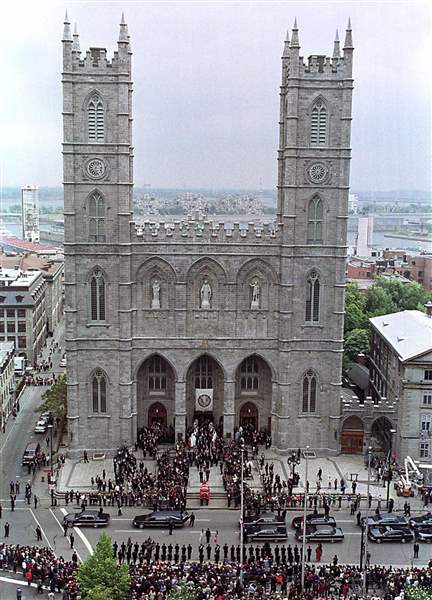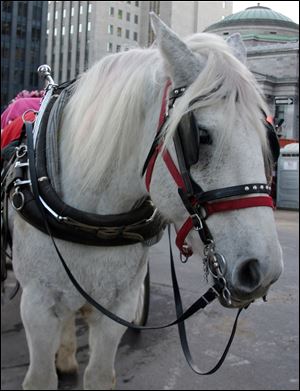
Montreal: A slice of Europe, not far from home
3/18/2012
Notre Dame Basilica is in Old Montreal, among blocks full of centuries-old buildings with architecture that even the most seasoned traveler will find both beautiful and amazing. The church's facade brings to mind its Parisian cousin.
Associated Press

Notre Dame Basilica is in Old Montreal, among blocks full of centuries-old buildings with architecture that even the most seasoned traveler will find both beautiful and amazing. The church's facade brings to mind its Parisian cousin.
"Je voudrais un crêpe de fromage et d'epinards, s'il vous plait."
And with that -- a breakfast order of a spinach and cheese crepe -- the French I was certain I had all but forgotten was beginning to come back.
Only about a day's drive from Toledo and surrounded by a country where most citizens speak English, Montreal is a little slice of Europe in the midst of North America. Whether walking the cobblestone streets winding through Old Montreal, sitting in one of the numerous cafes drinking strong coffee, or being enveloped in the rhythmic sound of French-speaking residents, visitors to Montreal can easily feel as though they are enjoying a day in France -- although depending on the time of year, they are likely bundled in a very thick coat.
Located at the southern tip of the province of Quebec, Montreal is the second largest city in Canada. Although it certainly has tall buildings and bustling traffic, Montreal offers something that most North American cities of 1.5 million-plus people don't have -- a truly European vibe.
Old Montreal, or Vieux-Montreal, is best enjoyed on foot. That way you can duck into one of the many bistros, bars, or souvenir shops, whether to take in the ambiance while sipping a glass of wine or, as was necessary during my recent trip, to escape from the winter chill.
Just off the St. Lawrence River quay, Old Montreal is made up of blocks full of centuries-old buildings with architecture that even the most seasoned traveler will find both beautiful and amazing. The area is a grid of narrow streets and is home to city hall, several courthouses, and the Notre Dame Basilica, whose façade brings to mind its Parisian cousin.
Churches abound in Montreal, each built centuries ago and which tend to inspire a feeling of both history and reverence. Among the churches I visited were the Cathedral-Basilica Mary Queen of the World and St. Patrick's Basilica, both masterpieces of art and architecture that loom among modern buildings full of corporate offices.
On the banks of the St. Lawrence River is the Old Port Quay. In winter, the city creates an ice rink on Bonsecours Basin where I found several skaters despite the frosty wind coming in off the nearby river. Armed with a cup of hot coffee, I walked along the river to the Clock Tower, which is listed in guide books as among the city's best lookouts. Built in 1922 to honor those who died at sea during World War I, the white tower marks the entrance to the Old Port.
Just across the water are Saint Helen Island and Notre Dame Island -- reached by either bridge or ferry -- which are home to parks, a casino, and the city's Biosphere Environment Museum.
While Old Montreal reminded me of older cities in France, Montreal's underground network of shops and restaurants was unlike anything I'd ever seen. Stretching for blocks and extending several floors underground, the various complexes -- including Complexe Les Ailes and Complexe Desjardins -- are a truly unique way to shop.

A horse pulling a carriage waits patiently outside in the cold in front of the Notre Dame cathedral in Montreal's Vieux Port old town section.
Have a map on hand. The seemingly endless network of corridors -- 18 miles in total -- can lead you to an exit far away from where you started.
While walking around the city, I came across random works of public art and small parks and squares. McGill University offers a pleasant walk on a beautiful campus, just blocks from the hustle of retail and commerce. And if you continue walking up the sloped portion of the city, north of the Museum Quarter, you'll come across Mount Royal Park -- an expanse of greenery that offers another spectacular view of the city. (And you'll be on the triple-peaked hill in the heart of the city that gave Montreal its name.)
The city is home to several museums, including the Fine Arts Museum, which is free and extends throughout three buildings. And, of course, I made a point of seeing Olympic Stadium, the focal point of the 1976 Summer Olympics. Although now known as the city's white elephant -- costing residents double its projected $1.5 billion bill and paid off only in 2006 -- the stadium is a beautiful piece of architecture, especially when lit up at night.
No stay in Montreal would be complete without a trip to the Bell Center, home of the Montreal Canadiens, the city's professional hockey team. Although the games are routinely sold out, visitors should at least attempt to get tickets to see the "Habs" and therefore experience the city's most popular sport.
Depending on your preferred mode of travel -- plane, train, or automobile -- the trip to Montreal is affordable. There are a plethora of hotels within walking distance of downtown's attractions and restaurants of every variety, including French cuisine. But one thing we can't rely on anymore is a currency exchange working in favor of the American dollar. The Canadian dollar is exchanged nearly one for one.
And yes, most people speak French. Both before and after my trip to Montreal, I heard from other travelers who shared stories of encounters with rude residents and less-than-helpful service providers. Each believed they were shunned for not speaking the city's native language of French. I didn't encounter that.
Of course, with a solid background in French, I recognize I had an advantage over those with no French language skills. Admittedly, all the menus in Montreal and the vast majority of the city's signs are in both French and English. That likely made my breakfast order that first day somewhat easier since there's no way I'd have remembered the word for spinach.
But throughout my stay, the Montrealers with whom I interacted, while ordering food, buying gifts, or asking for directions, always responded kindly -- albeit sometimes in English. Apparently my accent isn't as smooth as I thought.
There is enough to do in Montreal to keep a visitor busy for days. But even with having only a few days to explore, my time in the city transported me back to my years living in France. And most exciting -- and perhaps most terrifying -- was the ability to speak French.
"Montreal est vraiment une tranche de l'Europe facilement accessible de Toledo."
If You Go
Information about hotels, attractions, and current events can be found at the city's tourism Web site: www.tourisme-montreal.org.
The Montreal-Trudeau Airport is about a half-hour drive outside of downtown. The Via-Rail Canada's Central Station is located directly downtown.
Contact Erica Blake at: eblake@theblade.com or 419-213-2134.